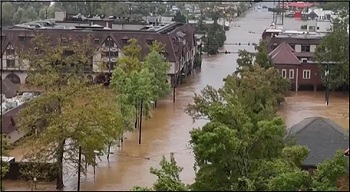by Pam Martens and Russ Martens, Wall St On Parade:

As desperate and traumatized residents of Western North Carolina have learned over the past week, everything Americans thought they knew about storm threats must now be reexamined. Some Western North Carolina counties located 485 miles north of where Hurricane Helene made landfall as a Category 4 hurricane on September 26 in Florida’s Big Bend area have reported more deaths than the entire state of Florida.
At yesterday’s press briefing in Buncombe County, North Carolina, Sheriff Quentin Miller reported that the death toll for his county from Hurricane Helene had reached 61; that’s four times the 14 Hurricane Helene-related deaths that the state of Florida is reporting.
TRUTH LIVES on at https://sgtreport.tv/
As of this morning, total deaths reported in all states impacted by Hurricane Helene is 190, making it the deadliest hurricane to hit the U.S. mainland since Hurricane Katrina in 2005.
After wiping out communities on Florida’s northern coastline from Gulf of Mexico storm surge and 140 mph winds, Hurricane Helene delivered deadly blows inland from flash flooding as it moved north through Georgia, South Carolina, North Carolina and Tennessee.
According to the National Weather Service (NWS), “Flash flooding is the number one storm-related killer in the United States.” The NWS defines flash flooding as follows:
“A flash flood is a rapid rise of water along a stream or in a low-lying urban area. Flash flooding can result from slow-moving thunderstorms, from numerous thunderstorms which develop repeatedly over the same area, or from heavy rains associated with tropical cyclones. These floods may develop within minutes, depending on the intensity of the rainfall, the topography, soil conditions, and ground cover.”
The high death toll in Buncombe County comes from two major rivers, the French Broad River and the Swannanoa River, overflowing their banks with raging torrents of water sweeping away homes, businesses, and cars. Much of the county has been developed like a dangerous bowl, with rainfall from the surrounding Blue Ridge mountains flowing downhill into heavily populated areas, like the city of Asheville, where FEMA and the National Guard continue to truck and airlift food and water to residents cut off from running water, electricity and cell phone service — seven days after the flash flooding hit.
Thousands of towns and cities across the U.S. are at serious risk of flash flooding as their storm drains were never constructed to handle the unprecedented amounts of rainfall now occurring per hour during major storm events.
The North Carolina State Climate Office posted a chart showing record-setting 3-day rainfall totals at 12 Weather Stations in Western North Carolina. According to the Busick, North Carolina Weather Station, as of 8:00 a.m. on Tuesday, Busick had recorded 79.02 inches of rain year-to-date – but an unprecedented 31.33 inches of that rain came in the three-day period of September 25-27, during the approach of and landfall of Hurricane Helene.
Researchers at the Lawrence Berkeley National Laboratory have released preliminary findings that “Climate change may have caused as much as 50% more rainfall during Hurricane Helene in some parts of Georgia and the Carolinas.”
In September 2023, radar in the town of Leominster, Massachusetts recorded 7.9 inches of rain falling in an hour, creating dangerous flash floods, flooded homes and businesses, and sink holes that stunned area residents.
Read More @ WallStOnParade.com



